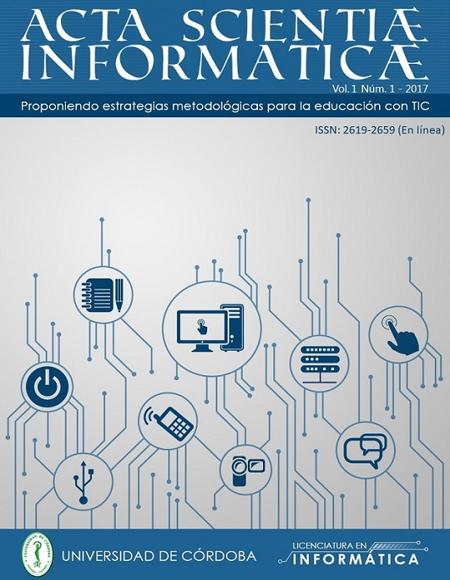Mostrar biografía de los autores
El modelado cognitivo es un campo creciente de la informática cognitiva que busca explicar como un ser humano resuelve un problema y a la vez capturar los pasos que dicha persona realizó para luego poder replicarlos con ayuda de una arquitectura cognitiva.
En este escrito se presentará un estudio general de los modelos cognitivos, sus características su clasificación y las arquitecturas cognitivas de mayor importancia en la actualidad y de cómo se ha utilizado al día de hoy el modelado cognitivo en la educación
Visitas del artículo 1063 | Visitas PDF
Descargas
- Amoruso, Lucia, Bruno, Mariano y Dominio, M. (2007). Algunas Diferencias Entre Modelos Simbólicos Y Conexionistas. XIV Jornadas de Investigación Y Tercer Encuentro de Investigadores En Psicología Del Mercosur., Facultad d, 0–2.
- Anderson, J. R. (2002). Spanning seven orders of magnitude: A challenge for cognitive modeling. Cognitive Science, 26(1), 85-112.
- Arrabales, R. (2013). Computación Cognitiva La nueva revolución del Big Data. ICEMD Instituto Economía Digital, 20.
- Berber, D., & Laaksonen, M. (2012) Problemas de coherencia y cohesión en resúmenes académicos por estudiantes finohablantes y suecohablantes de B1-B2 en dos universidades finlandesas
- Brandimonte, M. A., Bruno, N., & Collina, S. In P. Pawlik and G. d’Ydewalle (Eds.) Psychological Concepts: An International Historical Perspective. Hove, UK: Psychology Press, 2006.
- Borst, J. P., & Anderson, J. R. (2015). Using the ACT-R Cognitive Architecture in combination with fMRI data. In An introduction to model-based cognitive neuroscience (pp. 339-352). Springer New York.
- Busemeyer, J. R., & Diederich, A. (2010). Cognitive modeling. Sage.
- Cohen, M. A., Ritter, F. E., & Haynes, S. R. (n.d.). Herbal: A High-Level Language and Development Environment for Developing Cognitive Models in Soar. Retrieved from http://acs.ist.psu.edu/papers/cohenrh05.pdf
- Cavagnaro, D. R., Myung, J. I., Pitt, M. A., & Myung, J. (2013). Mathematical modeling. The Oxford handbook of quantitative methods, 1, 438-453.
- Duch, W., Oentaryo, R. J., & Pasquier, M. (2008, June). Cognitive Architectures: Where do we go from here?. In AGI (Vol. 171, pp. 122-136).
- Collins, A. & EE Smith.( 1988) Lecturas en ciencia cognitiva: Una perspectiva de la psicología y la inteligencia artificial. Morgan Kaufman Publishers Inc., San Mateo CA. http://penta.ufrgs.br/edu/telelab/3/symbolic.htm http://www.chrest.info/
- Chown, E. (2004). Cognitive Modeling. Computer Science Handbook, 1–14.
- Duch, W., Oentaryo, R. J., & Pasquier, M. (2008, June). Cognitive Architectures: Where do we go from here?. In AGI (Vol. 171, pp. 122-136).
- De León, J. M. R. S., & Blázquez, M. Á. F. Arquitecturas cognitivas y cerebro: hacia una teoría unificada de la cognición. Journal of Psychological Research, 4(2), 38-47.
- Feldman, J. A., & Ballard, D. H. (1982). Connectionist models and their properties. Cognitive science, 6(3), 205-254.
- Haan, A. (1987). K . Morik ( ed .), GWAI-87 11th German Workshop on Artifical Intelligence © Springer-Verlag Berlin Heidelberg 1987.
- Haan, A. (1987). K . Morik ( ed .), GWAI-87 11th German Workshop on Artifical Intelligence © Springer-Verlag Berlin Heidelberg 1987.
- Huertas Torres, 2014 O. Y. Una interpretación semántica de la lectura y comprensión de los problemas de matemáticas en las pruebas externas nacionales en el grado quinto (Doctoral dissertation, Universidad Nacional de Colombia).
- Iglesias Sánchez, Á. (2013). Modelo computacional cognitivo de toma de decisiones basado en el conocimiento: aplicación en la inferencia de explicaciones.
- Jacko, J. A., & Sears, A. (2012). Human Computer Interaction Handbook. CRC Press
- Lewis, R. L. (1999). Cognitive modeling, symbolic. The MIT encyclopedia of the cognitive sciences, 525-527.
- Laird, J. E. (2008). Extending the Soar cognitive architecture. Frontiers in Artificial Intelligence and Applications, 171, 224.
- Langley, P., Laird, J. E., & Rogers, S. (2009). Cognitive architectures: Research issues and challenges. Cognitive Systems Research, 10(2), 141-160
- Lawniczak, A. T., & Di Stefano, B. N. (2010). Computational intelligence based architecture for cognitive agents. Procedia Computer Science, 1(1), 2227-2235.
- Müller, J. P., Wooldridge, M. J., & Jennings, N. (1997). Intelligent Agents III. Agent Theories, Architectures, and Languages: ECAI'96 Workshop (ATAL), Budapest, Hungary, August 12-13, 1996, Proceedings (Vol. 3). Springer Science & Business Media
- Muller, T. J., Heuvelink, A., & Both, F. (2008, May). Implementing a cognitive model in soar and act-r: A comparison. In proceedings of Sixth International Workshop “From Agent Theory to Agent Implementation.
- Newell, A., Rosenbloom, P. S., & Laird, J. E. (1989). Symbolic architectures for cognition (No. AIP-62). CARNEGIE-MELLON UNIV PITTSBURGH PA ARTIFICIAL INTELLIGENCE AND PSYCHOLOGY PROJECT
- Profanter, S. (2012). Cognitive architectures. HaupteSeminar Human Robot Interaction.
- Russell, S. J., & Norvig, P. (2010). Artificial Intelligence. A Modern Approach. https://doi.org/10.1016/0925-2312(95)90020-9
- Ritter, F., Avraamides, M. N., & Councill, I. G. (2002). Validating changes to a cognitive architecture to more accurately model the effects of two example behavior moderators. In Proceedings of 11th CGF Conference.
- Ritter, S., Anderson, J. R., Koedinger, K. R., & Corbett, A. (2007). Cognitive Tutor: Applied research in mathematics education. Psychonomic bulletin & review, 14(2), 249-255.
- Ritter, F. E., Baxter, G. D., Jones, G., & Young, R. M. (2000). Supporting cognitive models as users. ACM Transactions on Computer-Human Interaction (TOCHI), 7(2), 141-173.
- Stemberg R. (1997). La Teoría Implícita Pentagonal
- Structures, R., Maps, M., & Thin-, S. (1996). Cognitive Modeling : Research Logic in, 2, 1–8.
- Sun, R. (2003). A tutorial on CLARION 5.0. Cognitive Science Department, Rensselaer Polytechnic Institute.
- Sun, R. (2001). Introduction to computational cognitive modeling. Cambridge handbook of computational psychology, 3-19Learning,
- Wang, Y. (2002). On cognitive informatics. In Cognitive Informatics, 2002. Proceedings. First IEEE International Conference on (pp. 34-42). IEEE
- Wang, Y. (2007). The theoretical framework of cognitive informatics. International Journal of Cognitive Informatics and Natural Intelligence (IJCINI), 1(1), 1-27.
- Wenstøp, F. (1976). Deductive verbal models of organizations. International Journal of Man-Machine Studies, 8(3), 293-311.
- Yingxu, W. (2003). On cognitive informatics. Brain and Mind, 4(November), 151–167. https://doi.org/10.1109/COGINF.2002.1039280
- Yingxu, W. (2003). On cognitive informatics. Brain and Mind, 4(November), 151–167. https://doi.org/10.1109/COGINF.2002.1039280


